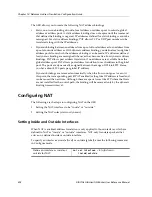
Chapter 13: IP Policy-Based Forwarding Configuration Guide
190
DIGITAL GIGAswitch/Router User Reference Manual
For example, the following commands create an IP policy called “p3”, which consists of
two IP policy statements. The
ip policy permit
statement has a sequence number of 1,
which means it is evaluated before the
ip policy deny
statement, which has a sequence
number of 900.
Setting Load Distribution for Next-hop Gateways
You can specify up to four next-hop gateways in an
ip-policy
statement. If you specify
more than one next-hop gateway, you can control how the load is distributed among
them. You can cause each new flow to use the first available next-hop gateway in the
ip-
policy permit
statement, or you can cause flows to use all the next-hop gateways in the
ip-policy permit
statement sequentially.
To set the load distribution for next-hop gateways, enter one of the following commands
in Configure mode:
Setting the IP Policy Action
You can specify when to apply the IP policy route with respect to dynamic or statically
configured routes. The GSR can cause packets to use the IP policy route first, then the
dynamic route if the next-hop gateway specified in the IP policy is unavailable; use the
dynamic route first, then the IP policy route; or drop the packets if the next-hop gateway
specified in the IP policy is unavailable.
gs/r(config)#
ip-policy p3 permit acl prof1 next-hop-list 10.10.10.10
sequence 1
gs/r(config)#
ip-policy p3 deny acl prof2 sequence 900
Use the first available next-hop
gateway in the
ip-policy permit
statement for all flows. This is the
default.
ip-policy
<name>
set load-policy
first-available
Sequentially pick the next gateway in
the list for each new flow.
ip-policy
<name>
set load-policy
round-robin
Determine the next hop gateway.
ip-policy
<name>
set load-policy ip-
hash sip|dip|both






























